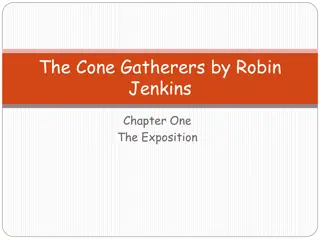Mastering the Art of Exposition through Development by Example
Understanding the importance of development by example in writing: from vague vs. specific examples to the three types of examples - series, specific, and explanation. Enhance clarity and impact in your writing by learning effective illustration techniques.
Download Presentation

Please find below an Image/Link to download the presentation.
The content on the website is provided AS IS for your information and personal use only. It may not be sold, licensed, or shared on other websites without obtaining consent from the author. Download presentation by click this link. If you encounter any issues during the download, it is possible that the publisher has removed the file from their server.
E N D
Presentation Transcript
Exposition Development by Example Wyrick, Jean. Steps to Writing Well with Additional Readings. Boston: Wadsworth, Cengage Learning, 2011. Print.
Development by Example Tina is an inconsiderate boor, impossible to live with. What do you say in response? What are you asking for?
Responses cite examples of Tinas lifestyle never washes her dishes, stays in the bathroom too long, borrows clothes without asking. Responses support and clarify her previous statement.
Example essays support, clarify, interest, and persuade.
Vague vs. Specific Examples Based on this description, do you know what educational shows are on channel 19? Probably not. You re probably thinking: Sesame Street Animal Planet Cupcake Wars History Channel The point is that we have to guess because the example isn t very clear.
Notice how this example is much more specific than the previous slide; there is no question about what educational shows are on Ch. 19. his is your goal as an illustration writer.
There are three types of examples you can use. The first type of example is the series example, which is like a list of examples in sentence format. The examples are specific and there is no development beyond that one sentence that explains the example.
Each sentence in this paragraph is a specific example and none of them are developed beyond one sentence this is a series example.
Outline for series example might look like this II. Hollywood actors adopt names A. Judy Garland B. Cary Grant C. Sandra Dee D. Troy Donahue E. Fred Astaire F. Lana
The second type of example is the two-in-one. There are only two examples in one paragraph and they are explained with more detail to support your main idea/thesis. The two examples are written in one paragraph. Each example is developed with four to seven sentences, which makes for a long paragraph that s okay! Let s take a look at a family pet named Sparky and his two attention-grabber tricks.
Did you notice how well developed each example is? The author provided enough detail for you to understand what Sparky does to get attention. The next slide shows how you d set up a two- in-one paragraph in an outline.
Outline for two-in-one example III. When Sparky doesn t get enough attention A. Record trick 1. Pushes an album out of rack 2. Gets the record out 3. Chews the record to pieces B. Cat-sit 1. Grabs the family cat 2. Sits on cat 3. Doesn t hurt cat
The last type of example is the extended example, which is one long, detailed example. It very much looks like a short story/narrative. This might be an anecdote (brief one-time story) that supports your thesis/purpose. Click for the next slide to read an extended example about seatbelts saving lives.
Outline for extended example IV. Seatbelts prevent injury A. Dad and I going to see grandparents B. We were being followed by a drunk driver C. Dad pulled over to check directions D. Drunk driver slammed into us E. Slammed us into the dashboard F. Seatbelts protected us
Illustration Essays are fairly simple to organize: The structure might look something like this: First paragraph: Introduction and thesis Body paragraphs as many as you need to support, clarify, interest, and persuade your reader. Each paragraph should have a topic sentences and examples necessary to explain or support the main idea. Last paragraph: appropriate conclusion
The examples you use should be relevant. Each example should support, clarify, or explain provide readers with more insight into the subject/thesis Keep purpose and main idea in mind Can the audience relate to the examples?
Your examples should be well chosen. Select only the strongest and most convincing examples Consider Current examples Can the audience relate Persuasion
Select enough examples to persuade and make each point clear. Put yourself in the reader s place, would you be convinced? Support your main points adequately. It s better to over-explain than to leave your reader confused, unconvinced and trying to figure out what your point is.
Examples should be clear, specific, and adequately detailed The reader needs to be persuaded with each example Give actual, real-life examples and experiences; general examples don t work nor do they convince Let your readers see what you explaining and describing; show, don t tell.
Arrange the examples in an order the best explains your major point Make sure each example is connected; use transition words such as: For instance For example To illustrate Another In addition
In summary: There are three types of examples: Series: list in sentence format Two-in-one: two adequately detailed examples in one paragraph Extended: one long, detailed example Examples can be interchangeably. Use each type or use only one i.e. extended examples from beginning to end. Select the most appropriate, most convincing examples Connect examples with proper transitions Support your thesis























